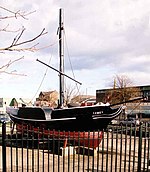Port Glasgow
Template:GBthumb Port Glasgow (Port Ghlaschu in Scottish Gaelic) is the second largest town in the Inverclyde Council Area in Scotland. It is located immediately to the east of Greenock and was previously a burgh in the former County of Renfrewshire.
The town grew from the central area of the present town and thus many of the towns historic buildings are found here. Port Glasgow expanded up the steep hills inland to open fields where areas such as Boglestone and Devol were founded. This area has subsequently become known as upper Port Glasgow and most of the town's population occupies these areas.
History

Port Glasgow was originally a small village known as Newark, possibly named after Newark Castle, in the parish of Kilmacolm. Trading ships from France and the low countries were unloaded here and the cargo taken up the River Clyde to Glasgow on smaller boats. In 1667, the town council of Glasgow purchased land for the construction of a harbour and breakwater. This became Glasgow's first deep-water port and the town of Newark became known as Port Glasgow (on some eighteenth century maps it is shown as Newport Glasgow). After 1693, the grid-iron street layout which still forms much of the town centre today, was laid out.
Shipbuilding
By the 19th century Port Glasgow had become a centre of shipbuilding. The Comet was built in the town in 1812 and was the first commercial steam vessel in Europe. A replica of the Comet and a plaque commemorating the actual site of construction are situated in Port Glasgow town centre.

Port Glasgow became a burgh in 1833, but around this time, the River Clyde up to Glasgow was deepened and new road and rail links meant that the town was no longer needed much as a port. The shipbuilding industry then took over as the main source of employment and prosperity. Port Glasgow has been responsible for about a quarter of the total tonnage of ships launched on the Clyde. however like the rest of Inverclyde this industry has all but gone and only Ferguson Shipbuilders yard remains in the town today and is one of the last privately owned shipyards left in Scotland.
Newark Castle
Newark Castle stands very close to the shore of the Clyde, and dates to around 1484. It was home to the Maxwell Family, but they no longer lived in the castle after 1694. By 1800 the castle was surrounded by shipyards, but today only Fergusons shipyard survives, standing close to the west of the castle, and an open park area and waterfront walkway have been landscaped to the east. The castle is now a visitor attraction owned by Historic Scotland.
Parliamentary burgh
Port Glasgow was a parliamentary burgh as a component of Kilmarnock Burghs from 1832 to 1918, when it was merged into the West Renfrewshire constituency. From 1974 to 1997 it was part of the Greenock and Port Glasgow constituency. It returned briefly to West Renfrewshire before forming part of the Inverclyde constituency in 2005. For Scottish Parliament purposes, Port Glasgow remains in the West Renfrewshire constiutency.
Areas of Port Glasgow
- Bardrainney
- Boglestone
- Bogston
- Bouverie
- Broadfield
- Devol
- Highholm
- Kelburn
- Lilybank
- Chapelton
- Mid Auchinleck
- Park Farm
- Parkhill
- Robert Street
- Slaemuir
- Springhill
- Town Centre
- Woodhall
Internal links
External links
- The Local Community Website
- Port Glasgow & photographs of Inverclyde
- Inverclyde Waterfront (Port Glasgow)
